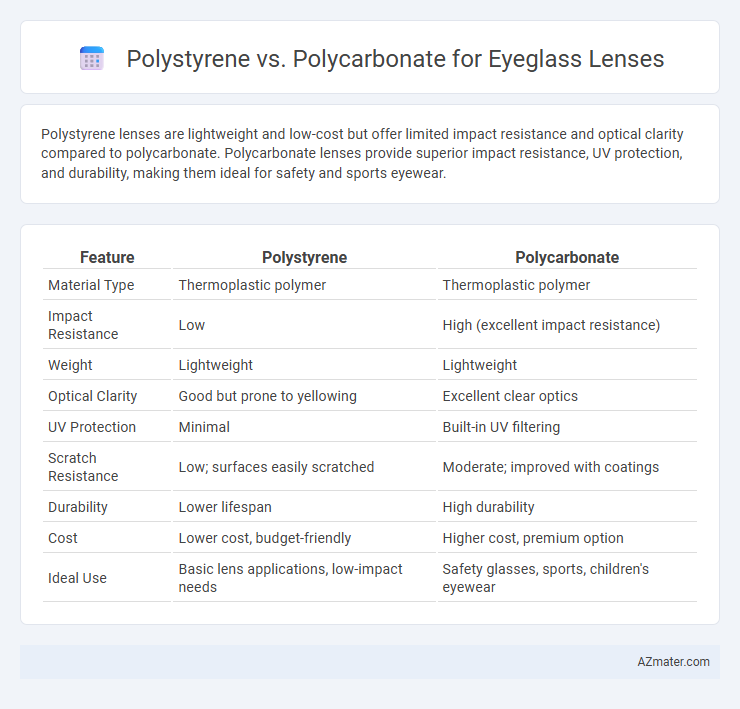Polystyrene lenses are lightweight and low-cost but offer limited impact resistance and optical clarity compared to polycarbonate. Polycarbonate lenses provide superior impact resistance, UV protection, and durability, making them ideal for safety and sports eyewear.
Table of Comparison
| Feature | Polystyrene | Polycarbonate |
|---|---|---|
| Material Type | Thermoplastic polymer | Thermoplastic polymer |
| Impact Resistance | Low | High (excellent impact resistance) |
| Weight | Lightweight | Lightweight |
| Optical Clarity | Good but prone to yellowing | Excellent clear optics |
| UV Protection | Minimal | Built-in UV filtering |
| Scratch Resistance | Low; surfaces easily scratched | Moderate; improved with coatings |
| Durability | Lower lifespan | High durability |
| Cost | Lower cost, budget-friendly | Higher cost, premium option |
| Ideal Use | Basic lens applications, low-impact needs | Safety glasses, sports, children's eyewear |
Introduction to Eyeglass Lens Materials
Polystyrene and polycarbonate are two popular materials used in eyeglass lenses, each offering distinct optical and physical properties. Polystyrene lenses are lightweight and provide excellent clarity but lack impact resistance, making them less durable for active wearers. Polycarbonate lenses combine high impact resistance with UV protection and lightweight comfort, making them a preferred choice for children and sports eyewear.
Overview of Polystyrene Lenses
Polystyrene lenses are a budget-friendly option commonly used in eyeglasses due to their lightweight and good optical clarity. These lenses offer basic scratch resistance but are more prone to impact damage compared to polycarbonate lenses. Ideal for low-cost eyewear, polystyrene provides adequate vision correction but lacks the durability and UV protection found in polycarbonate alternatives.
Overview of Polycarbonate Lenses
Polycarbonate lenses are a popular choice for eyeglasses due to their exceptional impact resistance and lightweight properties, making them ideal for safety glasses and active lifestyles. They offer superior UV protection by naturally blocking 100% of harmful ultraviolet rays, enhancing eye safety outdoors. Compared to polystyrene lenses, polycarbonate lenses are more durable, less prone to shattering, and provide better optical clarity, which contributes to improved visual comfort and longevity.
Optical Clarity: Polystyrene vs Polycarbonate
Polycarbonate lenses offer superior optical clarity compared to polystyrene, providing clearer and sharper vision essential for eyewear. Polystyrene lenses tend to have lower light transmission and higher distortion, which can affect visual performance negatively. Enhanced clarity and reduced aberrations make polycarbonate the preferred choice for high-quality eyeglass lenses.
Impact Resistance and Durability
Polycarbonate eyeglass lenses offer superior impact resistance compared to polystyrene, making them ideal for active lifestyles and safety glasses. While polystyrene lenses are more affordable, they lack the durability and shatterproof qualities of polycarbonate, which resists cracks and scratches under stress. Polycarbonate's high durability ensures longer-lasting eyewear performance, maintaining clarity and structural integrity over time.
Weight and Comfort Comparison
Polystyrene eyeglass lenses are lightweight but brittle, making them less durable and comfortable for extended wear compared to polycarbonate lenses. Polycarbonate lenses offer superior impact resistance and are significantly lighter than traditional glass, enhancing all-day comfort for users. The combination of low weight and high durability makes polycarbonate the preferred choice for eyeglass lenses in terms of comfort and safety.
UV Protection Capabilities
Polycarbonate lenses offer superior UV protection by blocking 100% of harmful UVA and UVB rays, making them highly effective for eyeglass lenses. Polystyrene lenses provide minimal UV protection, often requiring additional coatings to enhance their shielding capabilities. Choosing polycarbonate lenses ensures optimal eye safety against ultraviolet radiation without compromising optical clarity.
Cost Considerations
Polystyrene lenses offer a lower cost option for eyeglasses, making them attractive for budget-conscious consumers despite their lower durability and higher scratch susceptibility. Polycarbonate lenses, though more expensive, provide superior impact resistance and UV protection, justifying their higher investment for active lifestyles or children's eyewear. Evaluating cost-effectiveness involves balancing upfront material expenses against long-term benefits such as lens longevity and enhanced safety features.
Environmental Impact and Sustainability
Polystyrene eyeglass lenses are less environmentally friendly due to their non-biodegradable nature and challenges in recycling, contributing to long-term plastic waste. Polycarbonate lenses, while also derived from petroleum, offer better durability which prolongs product life and reduces overall environmental impact through fewer replacements. Advances in recycling technologies and the development of bio-based polycarbonate variants further enhance sustainability prospects for polycarbonate lenses compared to polystyrene.
Choosing the Right Lens Material for Your Needs
Polystyrene lenses are lightweight and affordable, making them suitable for basic eyeglasses but offer limited impact resistance and lower optical clarity compared to polycarbonate. Polycarbonate lenses provide exceptional durability, high impact resistance, and superior UV protection, ideal for active lifestyles or safety eyewear. Choosing polycarbonate ensures better safety and clarity, while polystyrene serves as a budget-friendly option for occasional use.

Infographic: Polystyrene vs Polycarbonate for Eyeglass Lens
 azmater.com
azmater.com